
Wetenschap
Houston, we hebben een probleem gehad:Apollo 13 onthouden op 50

Op deze 11 april 1970 foto ter beschikking gesteld door NASA, de Saturn V-raket die de bemanning van de Apollo 13-missie naar de maan vervoert, wordt gelanceerd vanuit het Kennedy Space Center in Florida. (NASA via AP)
De astronauten van Apollo 13 hebben nooit nagedacht over hun missienummer toen ze 50 jaar geleden naar de maan schoten. Zelfs toen hun zuurstoftank twee dagen later scheurde - op 13 april.
Jim Lovell en Fred Haise houden vol dat ze niet bijgelovig zijn. Ze gebruiken zelfs 13 in hun e-mailadressen.
Zoals missiecommandant Lovell het ziet, hij heeft ongelooflijk veel geluk. Hij overleefde niet alleen NASA's meest aangrijpende maanschot, hij is in de buurt om zijn gouden jubileum te vieren.
"Ik leef nog. Zolang ik kan blijven ademen, Het gaat goed met mij, "Lieve, 92, zei in een interview met The Associated Press van zijn Lake Forest, Illinois, huis.
Een halve eeuw later, Apollo 13 wordt nog steeds beschouwd als het beste uur van Mission Control.
Lovell noemt het 'een wonderbaarlijk herstel'.
haise, zoals zovele anderen, beschouwt het als NASA's meest succesvolle mislukking.
"Het was een geweldige missie, "Haise, 86, zei. Het toonde "wat er kan worden gedaan als mensen hun verstand en een beetje vindingrijkheid gebruiken."
Als piloot van de maanmodule, Haise zou de zesde man zijn geworden die op de maan liep, achter Lovell aan op het stoffige grijze oppervlak. De explosie van de zuurstoftank beroofde hen van de maanlanding, die NASA's derde zou zijn geweest, negen maanden nadat Neil Armstrong en Buzz Aldrin van Apollo 11 de eerste voetstappen van de mensheid op de maan zetten.

Deze foto van april 1970, beschikbaar gesteld door NASA, toont de aarde terwijl de Apollo 13-missie naar de maan gaat. (NASA via AP)
Nu heeft de pandemie van het coronavirus hen beroofd van hun jubileumvieringen. Feesten staan stil, onder meer in het Kennedy Space Center in Florida, waar de missie begon op 11 april, 1970, een zaterdag net als dit jaar.
Dat zal Haise niet stoppen, die nog steeds in Houston woont, van het markeren van wat hij "boomdag" noemt aanstaande maandag, zoals hij elke 13 april doet.
Liefs, Haise en Jack Swigert, een last-minute invaller die stierf in 1982, waren bijna bij de maan toen ze een knal hoorden en een huivering voelden. Een van de twee zuurstoftanks was gebarsten in de servicemodule van het ruimtevaartuig.
De gespannen woorden die volgden, zijn het spul van ruimte - en film - roem.
"OKE, Houston, we hebben hier een probleem gehad, " zei Swigert op de radio, de piloot van de commandomodule.
"Dit is Houston. Zeg nog eens, Alsjeblieft."
"Houston, we hebben een probleem gehad, ’ Lovell greep in.
Lovell meldde een plotselinge spanningsval in een van de twee belangrijkste elektrische circuits. Binnen enkele seconden, Houston's Mission Control zag de drukmetingen voor de beschadigde zuurstoftank tot nul dalen. De ontploffing schakelde ook twee elektrische energieopwekkende brandstofcellen uit en beschadigde de derde.
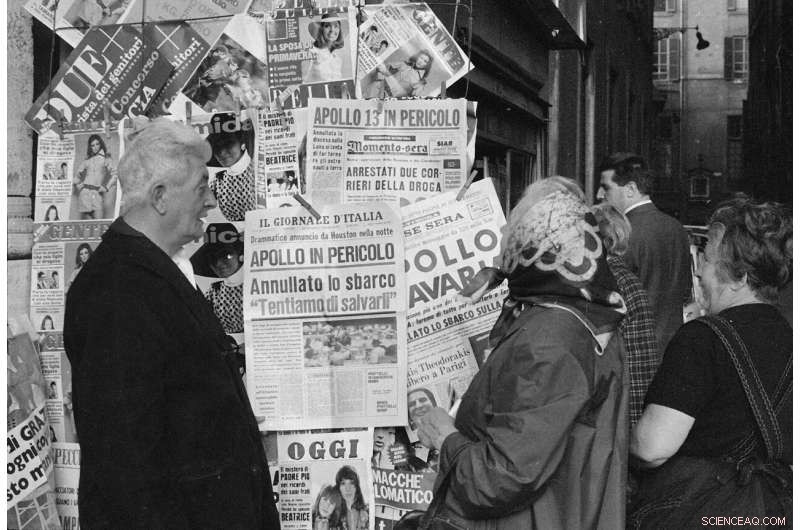
Op deze 14 april 1970 bestandsfoto, mensen in Rome kijken naar kranten die de krantenkoppen halen over de problemen die zich aan boord van de Apollo 13-missie van de VS ontwikkelden en die leidden tot de annulering van de poging om op de maan te landen. (AP-foto)
Terwijl Lovell uit het raam tuurde en zuurstof zag ontsnappen in de zwarte leegte, hij wist dat zijn maanlanding ook wegglipte. Hij schoof alle emoties opzij.
"Niet landen op de maan of sterven in de ruimte zijn twee verschillende dingen, "Liefde legde uit, 'en dus vergaten we de landing op de maan. Dit was er een van overleven. Hoe komen we thuis?'
De astronauten waren 200, 000 mijl (322, 000 kilometer) van de aarde. Om weer levend terug te komen zou kalmte nodig zijn, vaardigheid en, Ja, geluk.
"De explosie had niet op een beter moment kunnen gebeuren, ' zei Lovell.
Veel vroeger, hij zei, en de astronauten zouden niet genoeg elektrische stroom hebben gehad om rond de maan te komen en terug naar de aarde te slingeren voor een landing. Een ontploffing in een baan om de maan of, nog steeds slechter, terwijl Lovell en Haise aan de oppervlakte waren, "Dat zou het einde zijn."
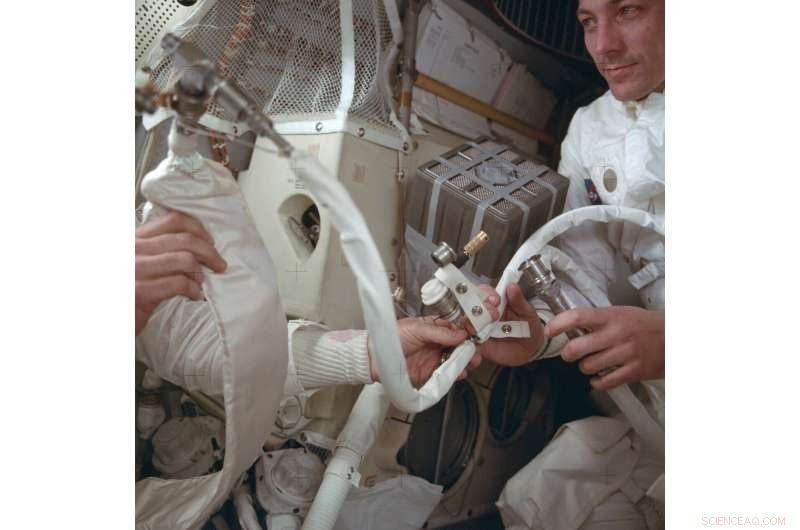
Op deze foto van april 1970, geleverd door NASA, Apollo 13 commandomodule piloot John Swigert helpt een lithiumhydroxide bus aan te sluiten in de maanmodule, in een poging om koolstofdioxide in de cabine kwijt te raken terwijl het ruimtevaartuig probeert terug te keren naar de aarde. De explosie van een zuurstoftank in de servicemodule dwong de driekoppige bemanning om op de maanmodule te vertrouwen als een 'reddingsboot'. (NASA via AP)
"Ik denk dat we goddelijke hulp hadden tijdens deze vlucht, ' zei Lovell.
De afgebroken missie werd zo saai dat geen van de grote tv-zenders minuten voor de explosie de show-and-tell van de astronauten uitzond. tot een drama op leven en dood dat de hele wereld in zijn greep houdt.
Terwijl vluchtdirecteur Gene Kranz en zijn team in Houston haastten om met een reddingsplan te komen, de astronauten hielden hun hoofd koel. Het was Lovells vierde ruimtevlucht - zijn tweede naar de maan - en de eerste en enige voor Haise en Swigert.
Donkere gedachten "snelden altijd door onze geest, maar stil. Daar hebben we het niet over gehad, ' zei Lovell.
Haise toegevoegd:"We hebben nooit het punt bereikt waarop er niets meer te doen was. Dus, Nee, we kwamen nooit op een punt waarop we zeiden:'We zullen, we gaan dood.'"
Het Witte Huis, minder zelfverzekerd, eiste kansen. Kranz weigerde, laat het aan anderen over om de kansen van de bemanning op 50-50 te zetten. In zijn gedachten, er was geen twijfel, geen ruimte voor mislukking - alleen succes.

Deze foto van april 1970, beschikbaar gesteld door NASA, toont de aarde terwijl de Apollo 13-bemanning naar de maan reisde. (NASA via AP)
"Dat was eigenlijk de naam van het spel:ik ga ze naar huis brengen. Mijn team gaat ze naar huis brengen. We zullen ze naar huis brengen, ’ herinnert Kranz zich.
Voor de goede orde, Kranz heeft nooit gezegd:"falen is geen optie." De lijn is puur Hollywood, gemaakt voor de film "Apollo 13" uit 1995 met Ed Harris als Kranz en Tom Hanks als Lovell.
De vluchtleiders gingen in crisismodus. Ze gaven onmiddellijk opdracht om de commandomodule Odyssey af te sluiten om het beetje stroom dat nog over was te sparen. en de astronauten om naar de maanmodule Aquarius te verhuizen, nu een reddingsboot.
Een van de dieptepunten, Lovell zei, besefte dat ze samen in de lander zouden zitten.
"Het is ontworpen voor twee personen voor twee dagen. We waren met drie personen voor vier dagen."
De overbelasting van kooldioxide, van ademen, dreigde hen te vermoorden.
Ingenieurs worstelden om erachter te komen hoe ze de vierkante luchtzuiverende bussen in de dode capsule konden omzetten in ronde exemplaren die in hun tijdelijke huis zouden passen.
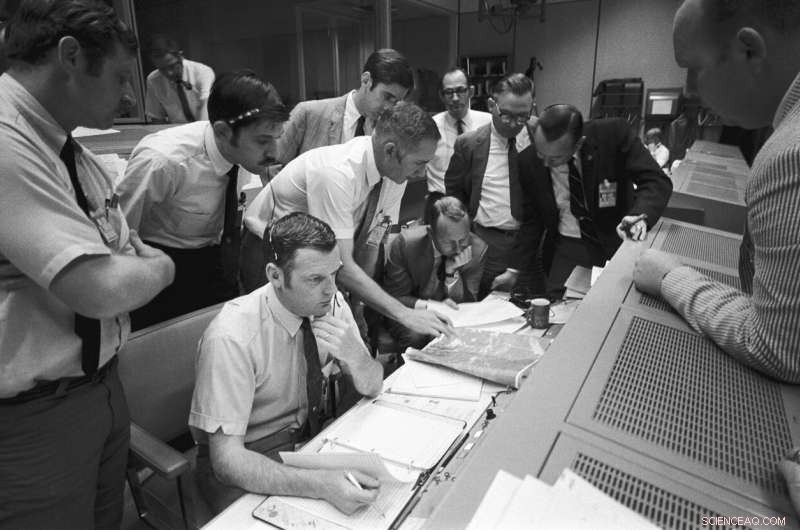
Op deze 15 april 1970 foto ter beschikking gesteld door NASA, een groep vluchtleiders verzamelt zich rond de console van Glenn S. Lunney, voorgrond zittend, Shift 4 vluchtdirecteur, in the Mission Operations Control Room (MOCR) of Mission Control Center (MCC) in Houston. Their attention is drawn to a weather map of the proposed landing site in the Pacific Ocean. Op dit punt, the Apollo 13 lunar landing mission had been canceled, and the problem-plagued Apollo 13 crew members were in trans-Earth trajectory attempting to bring their crippled spacecraft back home. (NASA via AP)
Their outside-the-box, seat-of-the-pants solution, using spacecraft scraps, worked. But it was so damp and cold that the astronauts couldn't sleep. Condensation covered the walls and windows, and the temperature was close to freezing.
Dehydrated and feverish, Haise had the roughest time during the six-day ordeal. Despite the sky-high stress, Haise recalls no cross words among the three test pilots. Even Swigert fit in, despite joining the crew a scant three days before liftoff. He replaced command module pilot Ken Mattingly, who with his crewmates had been exposed to German measles, but unlike them didn't have immunity.
Rumors swirled that the astronauts had poison pills tucked away in case of a hopeless situation. Lovell dispelled that notion on page one of his 1994 autobiography, "Lost Moon, " the basis for the "Apollo 13″ film.

This April 1970 photo made available by NASA shows astronaut Jim Lovell during the Apollo 13 mission. (NASA via AP)
Splashdown day finally arrived April 17, 1970—with no guarantees.
The astronauts managed to power up their command module, avoiding short circuits but creating a rainfall inside as the spacecraft decelerated in the atmosphere.
The communication blackout lasted 1 1/2 minutes longer than normal. Controllers grew alarmed. Eindelijk, three billowing parachutes appeared above the Pacific. It was only then, Lovell said, that "we knew that we had it made."
The astronauts had no idea how much their cosmic cliffhanger impacted the world until they reached Honolulu. President Richard Nixon was there to greet them.
"We never dreamed a billion people were following us on television and radio, and reading about us in banner headlines of every newspaper published, " Lovell noted in a NASA history.
The tank explosion later was linked to damage caused by electrical overheating in ground tests.
-
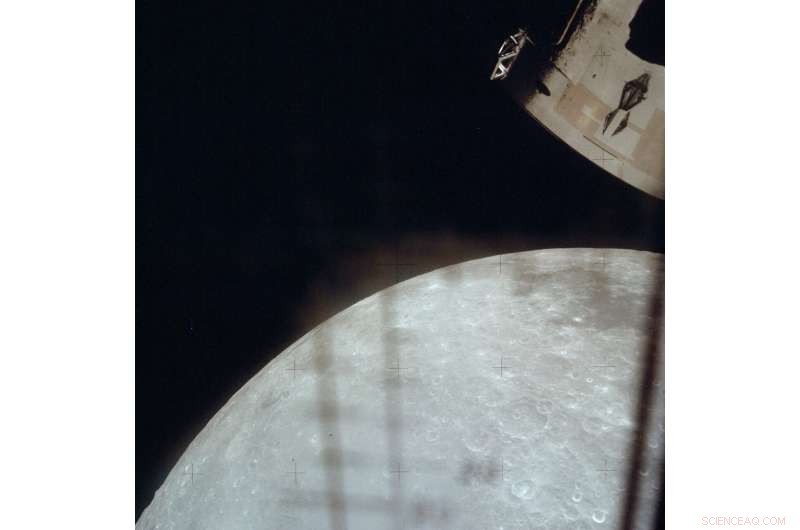
This April 1970 photo made available by NASA shows the moon through a window on the lunar module as the Apollo 13 crew heads back towards the Earth. (NASA via AP)
-

This April 1970 photo made available by NASA shows the interior of the Apollo 13 lunar module with the "mail box, " an ad hoc device which the crew assembled while in space to remove carbon dioxide from the air. It was designed and tested on the ground in Houston. Because of the explosion of one of the oxygen tanks in the service module, the three men had to use the lunar module as a "lifeboat" on their way back to Earth. (NASA via AP)
-
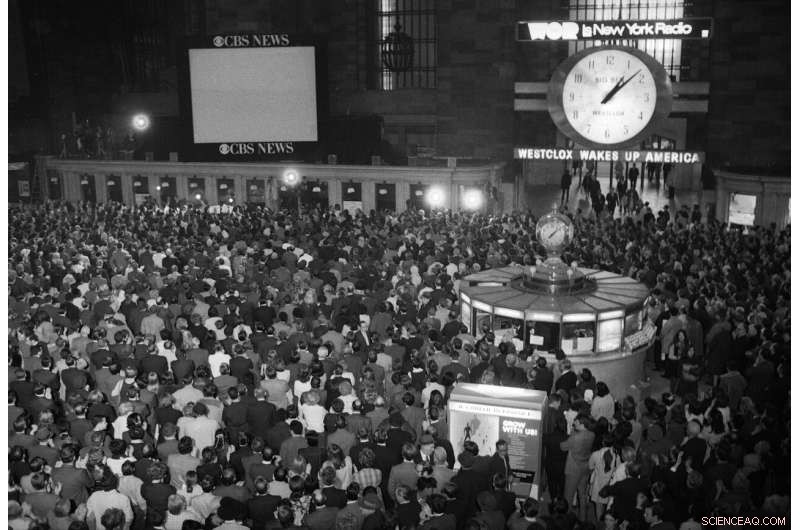
In this April 17, 1970 file photo, crowds watch a television screen in New York's Grand Central Station waiting for the safe arrival of the Apollo 13 astronauts in the Pacific Ocean. (AP Photo/J. Spencer Jones)
-
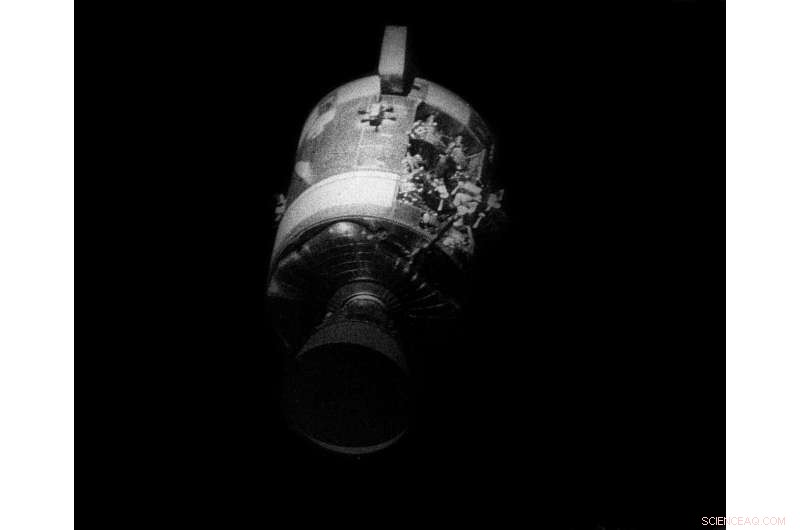
This April 17, 1970 photo made available by NASA shows the severely damaged Apollo 13 service module after separation from the lunar module/command module. An entire panel on the service module was blown away by the explosion of an oxygen tank. The damage forced the Apollo 13 crew members to use the lunar module as a "lifeboat." The lunar module was jettisoned just prior to Earth re-entry by the command module. (NASA via AP)
-
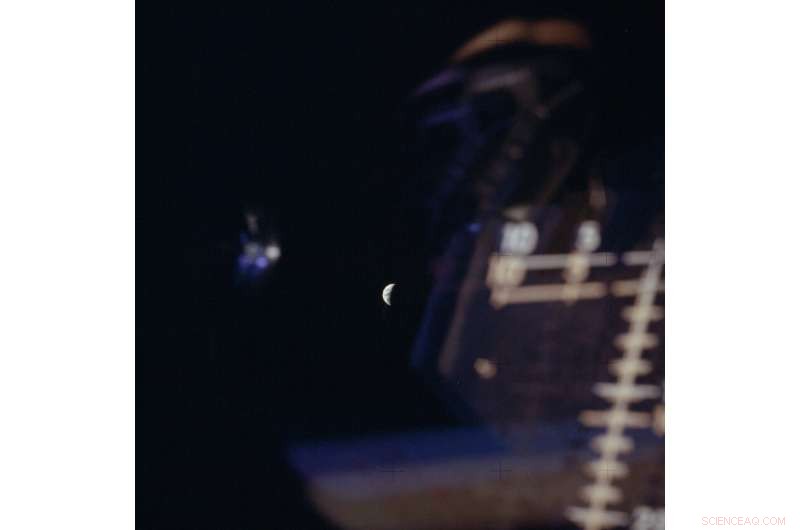
In this April 1970 photo made available by NASA, the Earth is seen though a window on the lunar module as the Apollo 13 crew heads towards home. (NASA via AP)
-
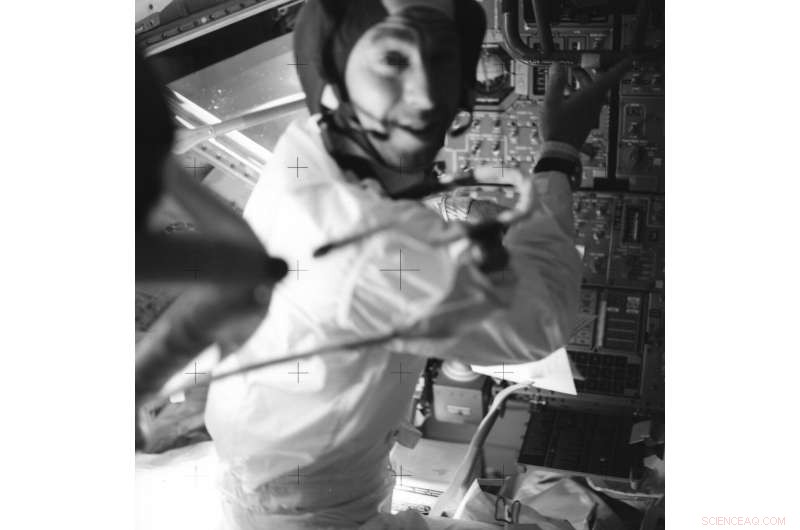
In this April 17, 1970 photo made available by NASA, astronaut Jim Lovell, inside the Apollo 13 lunar module, prepares it for jettison before returning to the command module for splashdown in the Pacific Ocean. (NASA via AP)
-
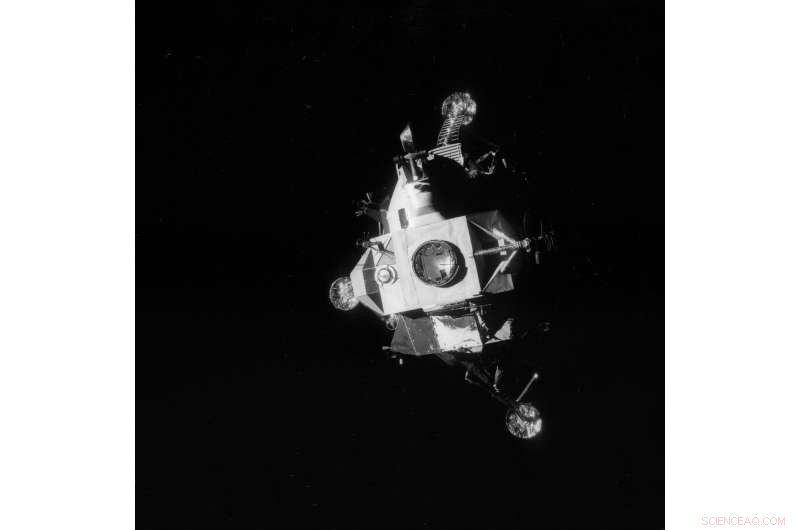
This April 17, 1970 photo provided by NASA shows the Apollo 13 lunar module photographed from the command module just after the lunar module was jettisoned, about an hour before splashdown of the command module in the Pacific Ocean. The explosion of an oxygen tank in the service module forced the Apollo 13 crew members to rely on the lunar module as a "lifeboat." (NASA via AP)
-

In this April 17, 1970 photo made available by NASA, astronaut Jim Lovell, commandant, is hoisted aboard a helicopter from the USS Iwo Jima, after splashdown of the Apollo 13 command module in the Pacific Ocean. (NASA via AP)
-

In this April 19, 1970 file photo, Apollo 13 astronaut Jim Lovell carries his son, Jef, 4, on his shoulders as he arrived at Ellington Air Force Base in Houston. (AP Photo)
-

In this April 17, 1970 photo made available by NASA, the command module carrying the Apollo 13 crew parachutes to a splashdown in the Pacific Ocean. (NASA via AP)
-

In this May 1, 1970 file photo, confetti falls from the skyscrapers in Chicago's financial district as Apollo 13 astronauts John Swigert and Jim Lovell ride in a motorcade during a parade in their honor. (AP Photo)
-
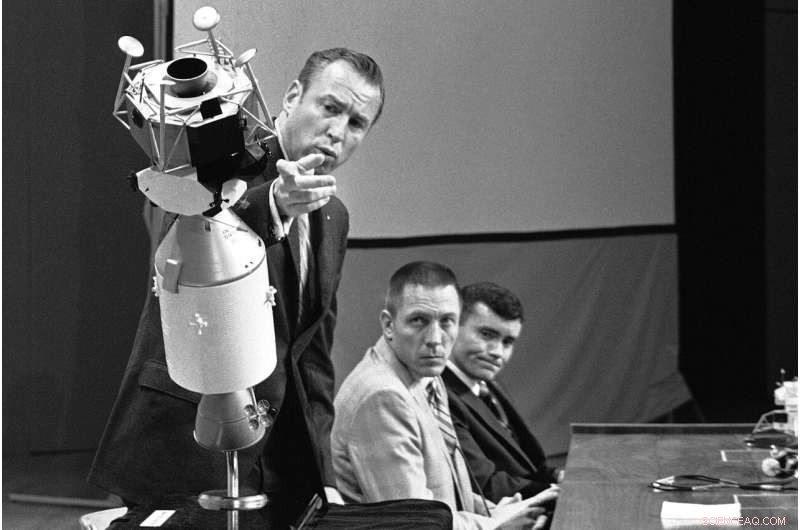
In this April 21, 1970 file photo, Apollo 13 commander Jim Lovell uses a scale model during a televised news conference at the Manned Spacecraft Center, Houston to explain how the crew managed to survive after the explosion that damaged the service module during their mission to the moon. At center is John Swigert, command module pilot, and at right is Fred Haise, lunar module pilot. (AP Photo)
-
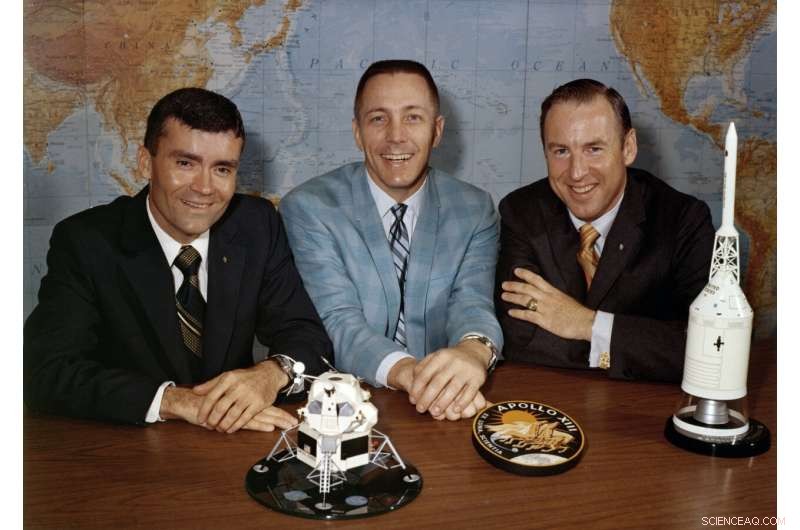
In this April 10, 1970 photo made available by NASA, Apollo 13 astronauts, from left, Fred Haise, Jack Swigert and Jim Lovell gather for a photo on the day before launch. (NASA via AP)
Apollo 13 "showed teamwork, camaraderie and what NASA was really made of, " said Columbia University's Mike Massimino, a former shuttle astronaut.
In the decades since, Lovell and his wife, Marilyn, of nearly 68 years have discussed the what-ifs and might-have-beens.
"The outcome of everything is, van nature, that he's alive, " ze zei, "and that we've had all these years."
© 2020 The Associated Press. Alle rechten voorbehouden. Dit materiaal mag niet worden gepubliceerd, uitzending, herschreven of gedistribueerd zonder toestemming.
 The Gorillas Ecosystem
The Gorillas Ecosystem  Dodelijke brand in Californië veroorzaakte verwoestende vuurtornado
Dodelijke brand in Californië veroorzaakte verwoestende vuurtornado Wolkenvorming en -distributie volgen eenvoudige thermodynamische, statistische wetten
Wolkenvorming en -distributie volgen eenvoudige thermodynamische, statistische wetten Studie kwantificeert mogelijke verspreiding van COVID-19 door orkaanevacuatie
Studie kwantificeert mogelijke verspreiding van COVID-19 door orkaanevacuatie Eerste meting stikstofverwijdering door lokale schelpdieren
Eerste meting stikstofverwijdering door lokale schelpdieren
Hoofdlijnen
- Onderzoekers identificeren hoe bacterie overleeft in zuurstofarme omgevingen
- Slagen, grote oceaanreservaten moeten zowel het zeeleven als de mensen ten goede komen
- Habitat telt wanneer roofdieren op de loer liggen
- Studie vindt toename van herbicide bij oudere volwassenen
- De rol van microfilamenten in cytokinese
- Eerste uitgebreide inventarisatie van Neotropische slangen
- Geven dieren bewustzijn aan?
- Bedoelden ze dat? Ongeval en opzet in een octopussentuin
- Het verschil tussen anafase, interfase, metafase en profase
- Fontein op melkwegschaal in volle glorie gezien

- Hubble ziet Marsmaan in een baan om de Rode Planeet

- Natuurkundigen leveren eerste model van rotatiedynamiek van manen, goed voor de solide innerlijke kern

- Wijnkelder in de ruimte:12 flessen komen aan voor het jaar van rijping
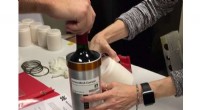
- Astronomen leveren eerste foto van zwart gat af

 Op prestaties gebaseerde beloning gekoppeld aan mentale gezondheidsproblemen van werknemers, studie toont
Op prestaties gebaseerde beloning gekoppeld aan mentale gezondheidsproblemen van werknemers, studie toont Belang van de elektrische eigenschappen van Gypsum
Belang van de elektrische eigenschappen van Gypsum Hoe mobiel werken de balans tussen werk en privé verpest – tenzij je een goede manager hebt
Hoe mobiel werken de balans tussen werk en privé verpest – tenzij je een goede manager hebt Een neon-transformator bedraden
Een neon-transformator bedraden  Deconcentratie is nodig om de emissies te verminderen en de overgang naar schone energiebronnen, vondsten melden
Deconcentratie is nodig om de emissies te verminderen en de overgang naar schone energiebronnen, vondsten melden Welke omgeving vormt waarschijnlijk siltstone of leisteen?
Welke omgeving vormt waarschijnlijk siltstone of leisteen?  Met vindingrijkheid en solidariteit, Cubanen bereiden zich voor op Irma
Met vindingrijkheid en solidariteit, Cubanen bereiden zich voor op Irma Collaboratieve luchtrobotarbeiders
Collaboratieve luchtrobotarbeiders
- Elektronica
- Biologie
- Zonsverduistering
- Wiskunde
- French | Spanish | Portuguese | Swedish | Dutch | Danish | Norway | Italian | German |

-
Wetenschap © https://nl.scienceaq.com

